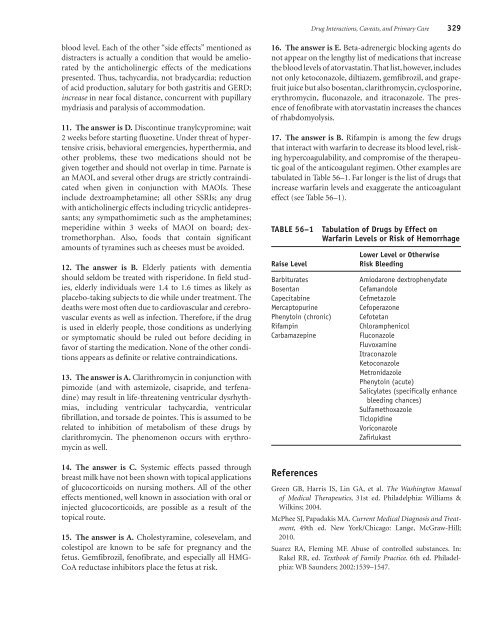NMS Q&A Family Medicine
NMS Q&A Family Medicine
NMS Q&A Family Medicine
- No tags were found...
You also want an ePaper? Increase the reach of your titles
YUMPU automatically turns print PDFs into web optimized ePapers that Google loves.
Drug Interactions, Caveats, and Primary Care 329blood level. Each of the other “side effects” mentioned asdistracters is actually a condition that would be amelioratedby the anticholinergic effects of the medicationspresented. Thus, tachycardia, not bradycardia; reductionof acid production, salutary for both gastritis and GERD;increase in near focal distance, concurrent with pupillarymydriasis and paralysis of accommodation.11. The answer is D. Discontinue tranylcypromine; wait2 weeks before starting fluoxetine. Under threat of hypertensivecrisis, behavioral emergencies, hyperthermia, andother problems, these two medications should not begiven together and should not overlap in time. Parnate isan MAOI, and several other drugs are strictly contraindicatedwhen given in conjunction with MAOIs. Theseinclude dextroamphetamine; all other SSRIs; any drugwith anticholinergic effects including tricyclic antidepressants;any sympathomimetic such as the amphetamines;meperidine within 3 weeks of MAOI on board; dextromethorphan.Also, foods that contain significantamounts of tyramines such as cheeses must be avoided.12. The answer is B. Elderly patients with dementiashould seldom be treated with risperidone. In field studies,elderly individuals were 1.4 to 1.6 times as likely asplacebo-taking subjects to die while under treatment. Thedeaths were most often due to cardiovascular and cerebrovascularevents as well as infection. Therefore, if the drugis used in elderly people, those conditions as underlyingor symptomatic should be ruled out before deciding infavor of starting the medication. None of the other conditionsappears as definite or relative contraindications.13. The answer is A. Clarithromycin in conjunction withpimozide (and with astemizole, cisapride, and terfenadine)may result in life-threatening ventricular dysrhythmias,including ventricular tachycardia, ventricularfibrillation, and torsade de pointes. This is assumed to berelated to inhibition of metabolism of these drugs byclarithromycin. The phenomenon occurs with erythromycinas well.14. The answer is C. Systemic effects passed throughbreast milk have not been shown with topical applicationsof glucocorticoids on nursing mothers. All of the othereffects mentioned, well known in association with oral orinjected glucocorticoids, are possible as a result of thetopical route.15. The answer is A. Cholestyramine, colesevelam, andcolestipol are known to be safe for pregnancy and thefetus. Gemfibrozil, fenofibrate, and especially all HMG-CoA reductase inhibitors place the fetus at risk.16. The answer is E. Beta-adrenergic blocking agents donot appear on the lengthy list of medications that increasethe blood levels of atorvastatin. That list, however, includesnot only ketoconazole, diltiazem, gemfibrozil, and grapefruitjuice but also bosentan, clarithromycin, cyclosporine,erythromycin, fluconazole, and itraconazole. The presenceof fenofibrate with atorvastatin increases the chancesof rhabdomyolysis.17. The answer is B. Rifampin is among the few drugsthat interact with warfarin to decrease its blood level, riskinghypercoagulability, and compromise of the therapeuticgoal of the anticoagulant regimen. Other examples aretabulated in Table 56–1 . Far longer is the list of drugs thatincrease warfarin levels and exaggerate the anticoagulanteffect (see Table 56–1 ).TABLE 56–1 Tabulation of Drugs by Effect onWarfarin Levels or Risk of HemorrhageRaise LevelBarbituratesBosentanCapecitabineMercaptopurinePhenytoin (chronic)RifampinCarbamazepineReferencesLower Level or OtherwiseRisk BleedingAmiodarone dextrophenydateCefamandoleCefmetazoleCefoperazoneCefotetanChloramphenicolFluconazoleFluvoxamineItraconazoleKetoconazoleMetronidazolePhenytoin (acute)Salicylates (specifically enhancebleeding chances)SulfamethoxazoleTiclopidineVoriconazoleZafirlukastGreen GB , Harris IS , Lin GA , et al. The Washington Manualof Medical Therapeutics , 31st ed . Philadelphia : Williams &Wilkins ; 2004 .McPhee SJ , Papadakis MA . Current Medical Diagnosis and Treatment, 49th ed . New York/Chicago : Lange, McGraw-Hill ;2010 .Suarez RA , Fleming MF . Abuse of controlled substances . In:Rakel RR , ed. Textbook of <strong>Family</strong> Practice . 6th ed . Philadelphia: WB Saunders ; 2002 :1539–1547.
















